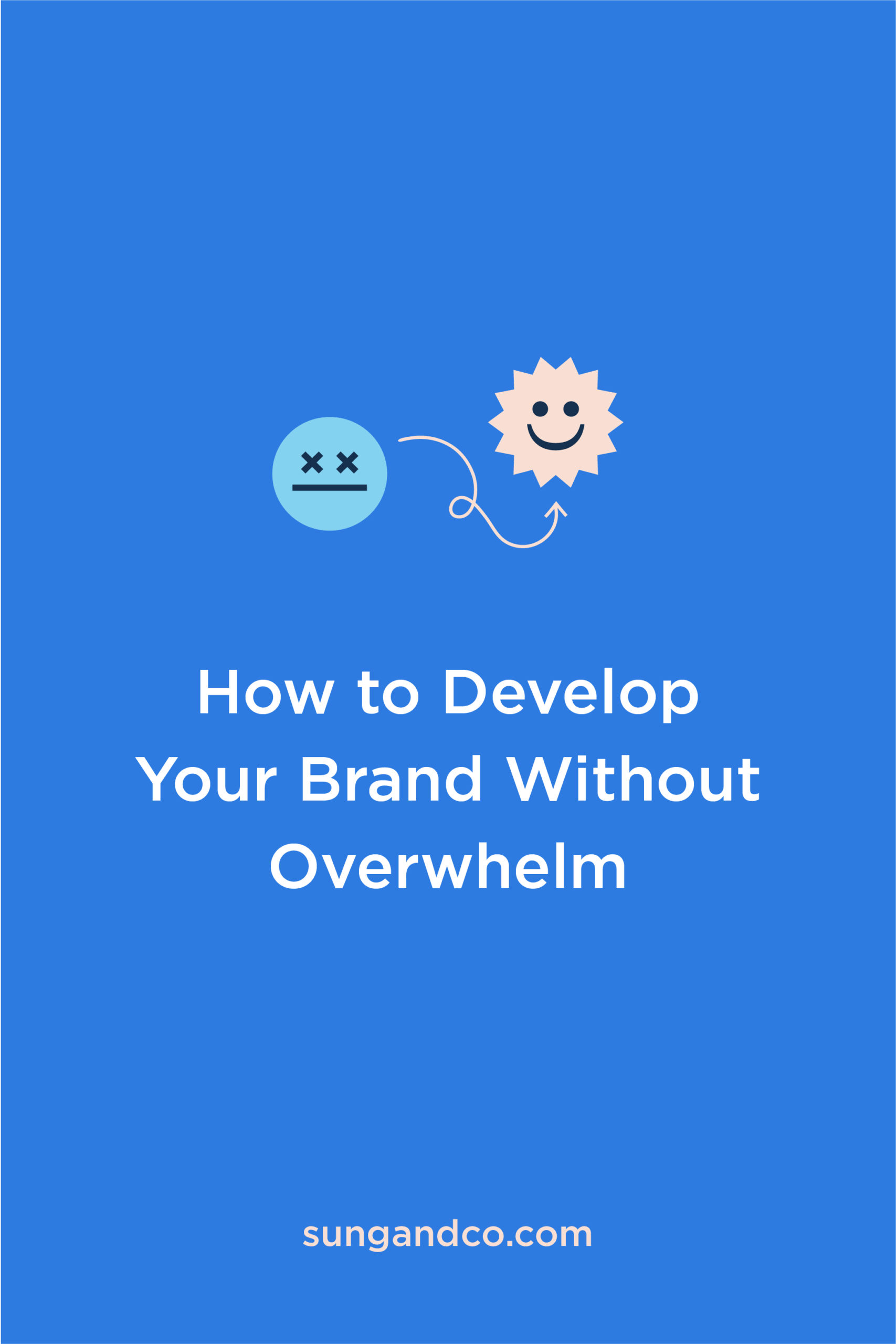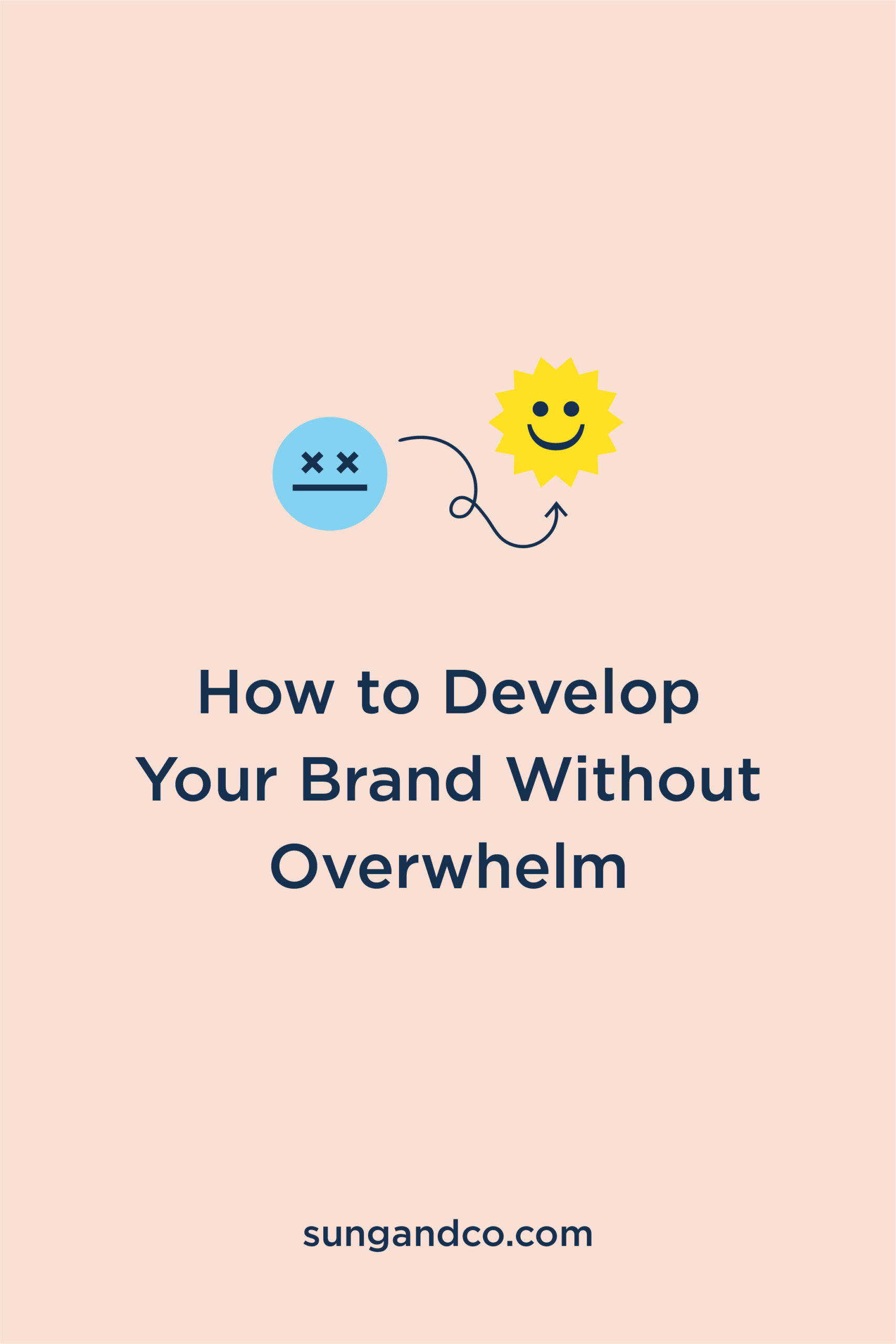If you’re working on developing your brand all by yourself, we know how hard it can be…especially if you’ve also got a long list of things you need to do for your actual business — client work, content creation, coaching calls, meetings, etc. We get it! So if you’re feeling a little overwhelmed with how you’re supposed to develop your brand, give yourself some grace.
We’ve tried to simplify the branding process in this post to help make your brand journey a little easier.

In this post, we will cover:
- Think through your overall business strategy.
- Figure out who your target audience is.
- Build an ideal client profile.
- Develop your brand positioning.
- Develop your brand messaging.
- Decide what you want to call your business.
- Develop your brand visuals.
- Develop your website.
- Always audit and refine your brand as you grow.
1. Think through your overall business strategy.
When you’re starting a business, it’s always good to know why you’re starting a business, what problem you’re trying to solve, who has this problem, and how you’re going to solve that problem. It sounds basic, but dig deep and provide as much detailed information as possible.
Go ahead and write out your Why, What, Who, and How. Writing things out on paper rather than having them stuck inside your head will help you communicate your messaging consistently throughout your brand. You’ll thank us later!
2. Figure out who your target audience is.
When you go into business to solve a problem, it’s good to know who you’re solving that problem for.
While it may be true that millions of people have the problem you’re trying to solve, we challenge you to narrow down your target audience to be in the age range of 5 to 7 years so that you can speak to a very specific group of people.
When you get detailed about who your target audience is, you’ll be able to get a better idea of how to position your brand.
3. Build an ideal client profile.
After you get focused on who your target audience is, think through who would be a perfect fit for your business by creating an ideal client profile.
An ideal client profile is a representation of a dream client based on the data, research, and feedback you’ve collected. We can’t tell you how helpful it is to have an ideal client profile when building anything for your brand. You should know your ideal client so well that you could write a book about them.
Having an ideal client profile will also help you make future branding decisions so much easier as you develop the rest of your brand. How? By keeping this person in mind, you’ll think through decisions based on if your ideal client would approve or what they would want and need.
4. Develop your brand positioning.
So now you know a little more about your business and who your business is for. Have you ever struggled with knowing how to stand out from your competitors? Developing your brand positioning helps you figure out how to differentiate your business from competitors with a similar target audience and offer.
What contributes to your brand positioning is the message you’re trying to tell your target audience, brand personality, offers, experience, and even your visuals…
To help figure out how you’ll stand out from your competitors, research them! Pick your Top 5 competitors and write out what they’re really great at, what might be missing from their services or products, and what you can do to offer something unique. The more ways you can set yourself apart will only help you stand out from the competition.

5. Develop your brand messaging.
Behind every great brand, is a great message. Your brand message communicates to your target audience what’s important to your business, what it stands for, and how it’s different from your competitors. Your brand messaging influences how people feel about your brand and helps them decide why your brand matters.
Ever watch a movie where someone is giving one of those epic speeches to rally a group of people (cue dramatic music in the background)? Your brand message should have the power to rally around your target audience.
6. Decide what you want to call your business.
Names are so stinkin’ hard to come up with. But come up with a name that best represents your brand. Names are not an “end all, be all,” but it sure does say a lot about your brand. You don’t have to be so literal (although it does help when someone is googling what they need help with). Get creative and combine words or concepts to come up with a solid name you’re proud of and one that you’ll be keeping around for a while.
7. Develop your brand visuals.
Create your logo, choose your color palette, and select your fonts. Instead of choosing something that your competitors use or something that’s currently trending, make decisions based on how you want people to see your brand and what your ideal client would be attracted to.
Colors, font choices, and the design of your logo do influence how your target audience perceives your brand. So when it comes down to making decisions about your brand, don’t make choices based on your personal preferences. Instead, be intentional and keep your ideal clients in mind.
8. Develop your website.
These days, websites are getting easier and easier to build yourself. But it’s not really about building a website or even making a website that just looks good…
Develop a website that’s strategic. A high converting website keeps your ideal clients in mind and guides them through a customer journey. A website built to generate new leads consistently is one that connects and resonates with the right people, one that delivers value, and one that converts potential customers into paying clients.
9. Always audit and refine your brand as you grow.
As your business grows, your brand will need to evolve with it. Having a full-time brand manager is nice, but if that’s not possible for you, we suggest that you do a brand review every year at the very least. Every quarter would be ideal.
Check-in and see where your brand is missing the mark. Is your website still relevant? Does it still resonate with your ideal clients? Are you launching anything new that will influence how your brand message is being communicated?
If you see any gaps in your brand, go back through this process and make sure that everything is aligned. When your brand is aligned, your strategy, visuals, and messaging should all work together cohesively and consistently.
Still feeling stuck and need some guidance? Book a free call and let us help you get out of the brand gap.
Until next time,
Happy Branding!



